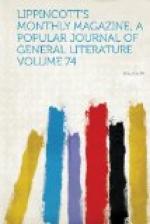The very ancient church of San Lorenzo, one of the four extramural basilicas, is situated some ten minutes’ walk outside the gate of the same name on the road to Tivoli; and around and behind this church is the vast cemetery to which all the Roman dead are carried. It was first used as an extramural cemetery at the time of the first French occupation, but has been very greatly extended since that time. Clergy, nobles and monks were at first, and as long as Papal rule lasted, exempted from the decree which forbade interment within the city. Now all must be taken to San Lorenzo, and the greatly increased population of the city has already very thickly filled an immense area. The first thing that strikes the visitor to this huge necropolis is the very marked division between the poor and the rich quarters of this city of the dead. The fashionable districts are quite as unmistakably divided and separated from those occupied by “the lower classes” as they are in any city of the living; as is perhaps but right and natural in the case of a population among which it is held that the condition and prospects of the dead may be very materially influenced by a quantum sufficit of masses said for them, and where these can be purchased in any quantity for cash. A very large parallelogram, for the most part surrounded by cloisters, is first entered from the gates which open on the road. But this has been but little used as yet. Beyond it, to the right, is the vast space occupied by the graves of the multitude. Let the reader picture to himself a huge flat space extending as far as the eye can see, thickly planted with little black wooden crosses, with inscriptions on them in white letters. The sameness of all these fragile memorials produces a strange and depressing effect. The undistinguished thousands of them make all the space seem black spotted with white. They are ugly; and the poverty of these bits of painted stick, incapable of resisting the effects of the weather, seems sordid in the extreme. In the graves of this part of the cemetery all are in truth equal. To the left of the vast cloister-surrounded square which has been mentioned the scene is a very different one. There, immediately behind the eastern end of the basilica, the soil rises in a very steep bank to a height greater than that of the church. To the space on the top of this bank a handsome and garden-decorated flight of step leads; and there the “Upper Ten” take their dignified rest, and their dust is perfectly safe from all danger of being mingled with that of less distinguished mortality. This higher ground is called the Pincetto—as who should say the “Little Pincian”—a name adapted from that of the celebrated promenade of the gay and fortunate in life, with a suggestion of meaning so satirical that it might seem to have been given to the “fashionable” quarter of the dead city by the united sneers of all the ghosts who haunt the undistinguished graves below. In




